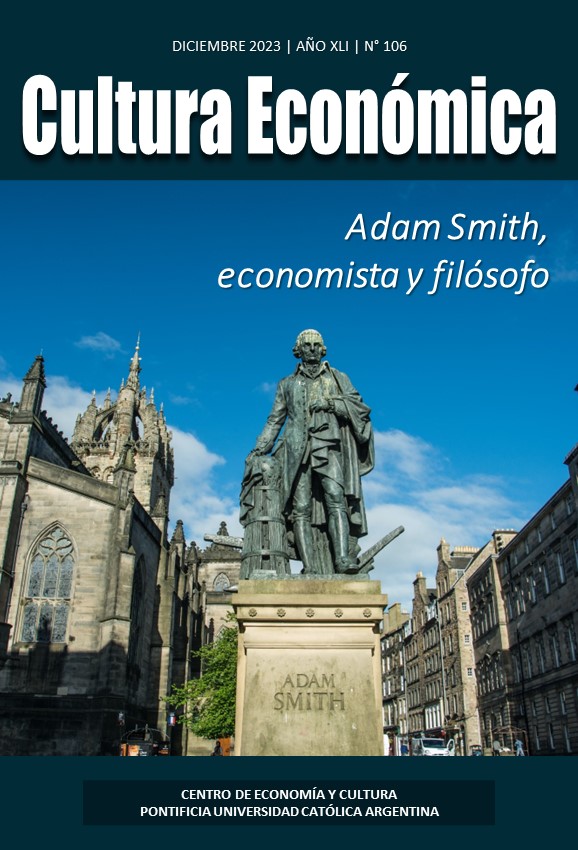Psyche and Reality (Relations illustrated by the Cosmological and Scientific Fragments of the Adam Smith's History)
DOI:
https://doi.org/10.46553/cecon.41.106.2023.p64-88Keywords:
Smith, psyche, reality, cosmology, politics, modern science, philosophyAbstract
The article makes use of the text entitled The principles which lead and direct philosophical enquiries; illustrated by the history of astronomy (1795) by Adam Smith in order to illustrate, analyze and ponder on the ways in which, throughout history, humankind has been weaving the links between psyche and reality to explain various irregularities (mainly astronomical). Likewise, as will be noted, the historical fragments implemented come as useful to identify a breaking point in these ways of weaving links. During the Copernican and Scientific Revolutions, a new entity would have emerged, with notorious legitimacy. This entity would guide, modern science and alter those traditional ways of establishing relations between psyche and reality, carrying metaphysical, subjective and epistemological implications into our current times.
Downloads
References
Beresñak, F. (2017). El imperio científico. Investigaciones político-espaciales. Miño y Dávila editores.
Beresñak, F. (2019). De Newton a Smith. Principios y leyes de la armonía –política– de los sentimientos. En Borisonik, H., Ludueña Romandini, F., & Acerbi, J. (Ed). Detrás del espectador imparcial. Ensayos en torno de Adam Smith (pp. 139-165). CLACSO-IIGG.
Bloch, E. (1959). Das Prinzip Hoffnung. Suhrkamp.
Borisonik, H. (2019). De la simpatía como imaginación. En Borisonik, H., Ludueña Romandini, F., & Acerbi, J. (Ed). Detrás del espectador imparcial. Ensayos en torno de Adam Smith (pp. 53-69). CLACSO-IIGG.
Copérnico, N. (2001). Sobre las revoluciones (de los orbes celestes). Tecnos.
Elena, A., Ordoñez, J., & Colubi, M. (ed.) (1998). Después de Newton: ciencia y sociedad durante la Primera Revolución Industrial. Editorial Anthropos.
Foucault, M. (2003). Las palabras y las cosas. Una arqueología de las ciencias humanas. Siglo XXI Editores.
Galilei, G. (1981). El ensayador. Aguilar.
Koyré, A. (1980). Galileo y la ley de la inercia. En Estudios galileanos. Siglo XXI Editores.
Koyré, A. (1985). La aportación científica del Renacimiento. En Estudios de historia del pensamiento científico. Siglo XXI Editores.
Koyré, A. (2008). Del mundo cerrado al universo infinito. Siglo XXI Editores.
Ludueña Romandini, F. (2019). El problema de los cuasi-trascendentales en la economía política de Adam Smith. Un abordaje teológico-político. En Borisonik, H., Ludueña Romandini, F., & Acerbi, J. (Ed). Detrás del espectador imparcial. Ensayos en torno de Adam Smith (pp. 37-52). CLACSO-IIGG.
Newton, I. (2006). De gravitatione et aequipondio fluidorum y De aere et aethere (ca. 1673-1675). En Benitez, L., & Robles, J. A. (Eds.). De Newton y los newtonianos entre Descartes y Berkeley. Universidad Nacional de Quilmes.
Newton, I. (2011). Principios matemáticos de la Filosofía Natural. Alianza.
Ortega y Gasset, J. (1979). La idea de principio en Leibniz y la evolución de la teoría deductiva. Alianza.
Ottonello, R. O. (2019). Los insensibles y lo Invisible en La riqueza de las naciones. En Borisonik, H., Ludueña Romandini, F., & Acerbi, J. (Ed). Detrás del espectador imparcial. Ensayos en torno de Adam Smith (pp. 21-35). CLACSO-IIGG.
Ratzinger, J. (1993). La crisis de la fe en ciencia. Sección del capítulo 4: La fe y las convulsiones socio-políticas contemporáneas. En Una mirada a Europa. Rialp.
Smith, A. (1997). La teoría de los sentimientos morales. Alianza.
Smith, A. (1998). Los principios que presiden y dirigen las investigaciones filosóficas, ilustrados por la historia de la astronomía. En Ensayos filosóficos. Ediciones Pirámide.
Reeder, J. (1998). Estudio Preliminar. En Smith, A. Ensayos filosóficos. Ediciones Pirámide.
Downloads
Published
How to Cite
Issue
Section
License

This work is licensed under a Creative Commons Attribution-NonCommercial-ShareAlike 4.0 International License.













